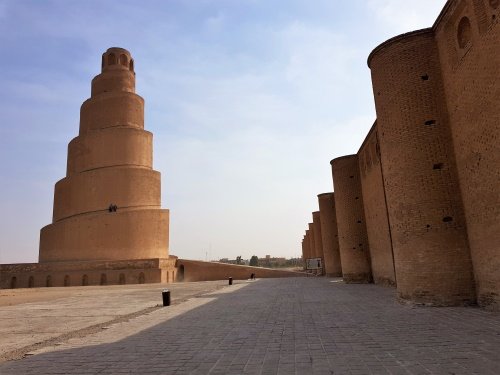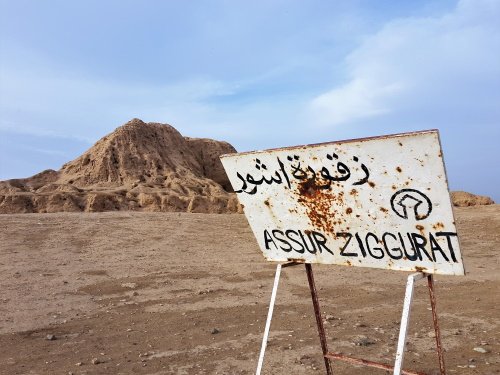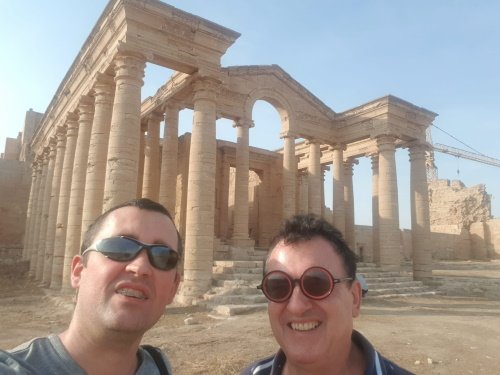Els Slots
Wojciech and Thomas ... In Iraq
Iraq’s WHS have seriously been underreviewed at this website: Ashur and Babylon so far had none, Samarra showed one visit from 1975, and Hatra had only reports by 2 US military personnel. While Iraqi Kurdistan has been easily accessible for the past 10 years or so, Iraq “proper” is now opening up more as well, aided by the introduction of a visa-on-arrival for nationals of 38 countries . The area around Baghdad is deemed safe enough, but what about the ancient cities around Mosul? Wojciech Fedoruk and Thomas Buechler put WH travel in Iraq to the test a few weeks ago. They've written reviews of the sites they managed to visit (spoiler alert: they reached all 6!) and share more stories below.

What’s the most efficient itinerary along Iraq’s 6 WHS?
Wojciech: “I planned to cover all Iraqi WHS within 7 days and it worked very well. It is recommended to start from Iraq ‘proper’: a visa issued in Baghdad is respected in Kurdistan, but the one issued in Kurdistan is valid only there, so you’d have to pay twice:
- Day one – early arrival at Baghdad airport, taxi to Babylon WHS , then to Ur - part of Ahwar of Southern Iraq WHS , after that to Baghdad. I started at 6 AM and reached my hotel in Baghdad at around 5.30 PM. It includes over 700km of driving but most of this is on wide Basra - Baghdad road where literally everybody with a decent car drives at a speed exceeding 150 kmph – no speed checks at all.
- Day two – Baghdad. If you hunt for WHS only, you should skip day two and stay near Ur, visit proper Iraqi marshlands and go back to Baghdad on that day.
- Day three – Samarra WHS and Ashur WHS , overnight in Mosul
- Day four – early visit in Mosul old town (could possibly be replaced by Nineveh TWHS, but after its intentional destruction by ISIS there is literally nothing left), Hatra WHS , back to Mosul
- Day five – Mar Behnam Monastery, Nimrud TWHS , taxi to Erbil, on the way we visited TWHS Lalish temple
- Day six and seven – Erbil Citadel WHS , Erbil and surroundings. This could be limited even to one day, but you need a PCR test to leave Erbil, so you have to plan it in advance.”
How did you organize it?
Thomas, who had visited the South of Iraq already on an organized trip in 2018 but found the North off-limits at the time, shares: “For the Northern circuit and its 3 UNESCO sites of Samarra, Hatra and Ashur the crucial thing here is to travel with the right guide. We were just 3 men and could travel uncomplicated in one car with a driver and guide. There were lots of police check-ups, a few times we had to leave the car and register. It happened also that we had to leave our passports behind, and could only collect them again upon leaving the sites.” This doesn’t need to be an official tourist guide, but a person with the right local relations and who can arrange things at numerous checkpoints.

Your biggest travel achievement of this trip must be getting into Ashur and Hatra?
Wojciech: “These two are officially closed and nobody can officially guarantee letting you in. We had a very young fixer who didn’t care about the obstacles and with his help we managed to visit those two. Ashur was no issue as the chief guard of this place was his close friend (or relative). In Hatra we spent almost three hours waiting at the checkpoint until our permit came from Baghdad. Our fixer arranged it on the spot, sending our passport scans to Baghdad by Whatsapp. Overall, we were super lucky, as very few foreign travellers had the possibility to visit these two WHS after their recapture from ISIS.”
How is the current state of these 2 sites?
“Ironically, Ashur did not suffer that much, only because there was not so much to destroy – the remains were not that significant even before ISIS came there. All the important artifacts from Ashur were taken out a long time ago, mostly to the Iraqi Museum in Baghdad and Pergamon Museum in Berlin. ISIS completely destroyed the local museum and the guard’s house. Bullet shells from that time are still easy to find in Ashur, there is also a place where – as we were said – they executed hostages. Ashur is beautifully located on the bend of the Tigris river and this location is its curse. The Iraqi government plans to build a dam that may possibly threaten the archeological site and this is also a reason to put it on ‘In Danger’ list. The site looks rather abandoned, some works are performed on the entrance gate, which, apart from the Ziggurat, is the most significant visible remaining.”
“For Hatra, initial reports were frightening – the site was supposed to be systematically destroyed similarly to Syrian Palmyra. Fortunately, it didn’t happen – ISIS ‘only’ destroyed anything with images of humans and animals – such as reliefs and sculptures, some used as shooting targets for beginning recruits. Impressive city walls, columns, and most of the buildings survived. There are intensive reconstruction works by Italian archeologists and, as we were told, the site will be closed until they finish. I am a bit afraid that after reconstruction the site will be even less authentic, as the reconstruction of Iraqi monuments usually goes too far for Western standards – check Babylon for example.”

What were the highlights of the TWHS?
According to Thomas:
- Nimrud : once one of the most magnificent archaeological sites in the Middle East. A 3,000-year-old Assyrian city with lots of sculptures and frescos of the highest quality. But all of it has been destroyed by ISIS 2014/15 in an act of barbarity, even on a larger scale than what they did in Palmyra. It affected most of its structures like the winged bulls and lions, the ziggurat, the palaces of king Ashurnasirpal II, and the old gates, all turned into rubbles. With the support of UNESCO and Foreign governments, there are plans to rehabilitate Nimrud in its grandeur, but during our visit, the entire property was fenced off and guarded, and no archaeologists were there except one Iraqi specialist. There were closed tents where some of the antiquities are being kept. Officially the site is closed to visitors but we were given a brief tour, no photos allowed except in front of a stone relief (with hundreds of bullet holes) similar to the one that was sold for $ 31 million at a Christie’s in 2018.
- Old City of Mosul : it has been heavily destroyed by ISIS. The Great Mosque of al-Nuri with its famous leaning minaret was first used by ISIL in 2014 to declare the formation of a new caliphate but then blown in 2017 up shortly before the Iraqi army arrived. There is an ongoing reconstruction project, with the support of $50M by the UAE. The extent of destruction elsewhere in the Old City is massive, but people have returned to normal life. The local market is very busy, selling fresh fish, fruits, and vegetables. And there is horrendous traffic, especially in the evenings, crossing the Tigris river. Bridges have been destroyed in the conflict, and are currently being renovated, restoring the east-west access. As we experienced, a crossing can take up to 3 hours.
- Personally, the most impressive was the Wadi Al-Salam Cemetery in Najaf that I had the chance to visit in 2018. It is the biggest cemetery I have ever seen worldwide and contains more than 5 million bodies. Some war heroes with huge portraits in their military gear, and religious flags, there is a unique ambiance over the place or at least parts of it.
The photos from top to bottom show Samarra WHS, Ashur WHS, and the intrepid duo in front of Hatra WHS (including a crane in the background from the Saddam Hussein era). All photos are courtesy of Wojciech & Thomas. Their reviews of Hatra and Ashur have been published already, and Babylon will follow in the next week.
More on
Els SlotsComments
No comments yet.
